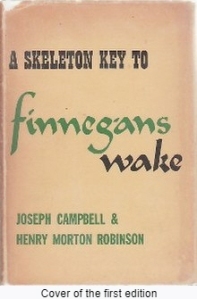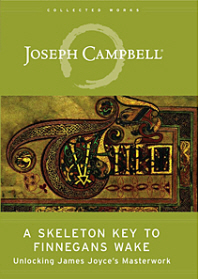‘A Skeleton Key to Finnegans Wake’ by Campbell and Robinson
When the comic, mythic, and dream-like epic Finnegans Wake was released in 1939 after a 17-year effort by James Joyce, most readers–including top reviewers–dismissed it as gibberish. Four years later, Joseph Campbell (The Hero With a Thousand Faces) and Henry Morton Robinson (The Cardinal) explained Joyce’s novel so well that for years A Skeleton Key to Finnegans Wake was the only book that covered the entire novel rather than simply annotating “difficult” references in its text.
 The Joseph Campbell Foundation (JCF), which maintains all of Campbell’s published and unpublished materials, has kept a skeleton key in print with a new introduction. I appreciate the work of JCF and while its website has evolved over the years, I enjoy spending time there where Campbell’s mythic look at the world is kept alive along with books like A Skeleton Key that are still viable long after their publication.
The Joseph Campbell Foundation (JCF), which maintains all of Campbell’s published and unpublished materials, has kept a skeleton key in print with a new introduction. I appreciate the work of JCF and while its website has evolved over the years, I enjoy spending time there where Campbell’s mythic look at the world is kept alive along with books like A Skeleton Key that are still viable long after their publication.
James Joyce is my favorite author and Finnegan’s Wake is my favorite novel, in part for its humor and scope and in part because it’s a vital component of linked novels that constituted his life’s work. Suffice it to say, the work of Campbell (March 26, 1904 – October 30, 1987) and Henry Robinson (September 7, 1898 – January 13, 1961) made my frequent journeys through the Wake much more easier. Like carrying a strong flashlight in a dark cave.
Edmund Wilson of “The New Yorker” said, “Campbell and Robinson deserve a citation from the Republic of Letters for having succeeded in bringing out their Skeleton Key at this time….The chance to be among the first to explore the wonders of Finnegans Wake is one of the few great intellectual and aesthetic treats that these last bad years have yielded.”
Max Lerner of “The New York Times” said, “Joyce has found in Mr. Campbell and Mr. Robinson the ideal readers who approach his book with piety, passion, and intelligence, and who have devoted several years to fashioning the key that will open its treasures.”
From the Publisher
 “Countless would-be readers of Finnegans Wake — James Joyce’s 1939 masterwork, on which he labored for a third of his life — have given up after a few pages and dismissed the book as a perverse triumph of the unintelligible. In 1944, a young professor of mythology and literature named Joseph Campbell, working with novelist and poet Henry Morton Robinson, wrote the first guide to understanding the fascinating world of Finnegans Wake. Page by page, chapter by chapter, A Skeleton Key to Finnegans Wake outlines the basic action of Joyce’s book, simplifies and clarifies the complex web of images and allusions, and provides an understandable, continuous narrative from which the reader can venture out on his or her own. This edition includes a foreword and updates by Joyce scholar Dr. Edmund L. Epstein that add the context of sixty subsequent years of scholarship.”
“Countless would-be readers of Finnegans Wake — James Joyce’s 1939 masterwork, on which he labored for a third of his life — have given up after a few pages and dismissed the book as a perverse triumph of the unintelligible. In 1944, a young professor of mythology and literature named Joseph Campbell, working with novelist and poet Henry Morton Robinson, wrote the first guide to understanding the fascinating world of Finnegans Wake. Page by page, chapter by chapter, A Skeleton Key to Finnegans Wake outlines the basic action of Joyce’s book, simplifies and clarifies the complex web of images and allusions, and provides an understandable, continuous narrative from which the reader can venture out on his or her own. This edition includes a foreword and updates by Joyce scholar Dr. Edmund L. Epstein that add the context of sixty subsequent years of scholarship.”
“Running riddle and fluid answer, Finnegans Wake is a mighty allegory of the fall and resurrection of mankind. It is a strange book, a compound of fable, symphony, and nightmare–a monstrous enigma beckoning imperiously from the shadowy pits of sleep. “
As they say, it’s a monomyth, not just about residents of Dublin “but the dreamlike saga of a guilt-stained, evolving humanity.”
The festivities begin when laborer Tim Finnegan gets drunk, falls off a ladder, and dies, but then comes to back to life during his wake when whisky gets splashed on him. This sets the tone for the novel with its cycles of death and rebirth.



